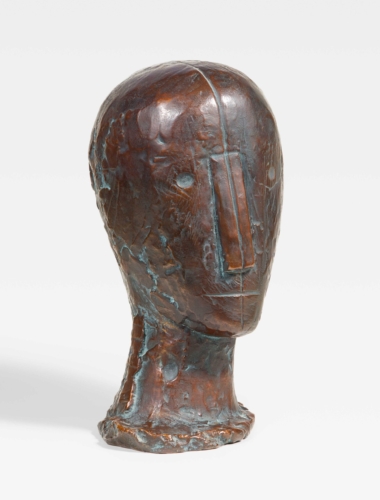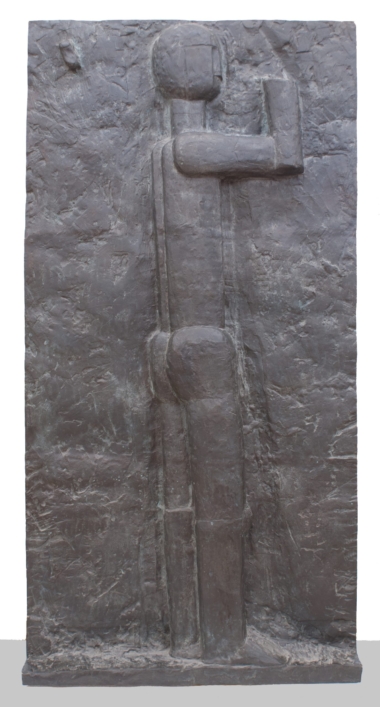Fritz WOTRUBA wurde am 23. April 1907 in Wien geboren. Von 1921 bis 1924 absolvierte er eine Ausbildung zum Graveur. In den Jahren 1926 bis 1929 studierte er Bildhauerei an der Kunstgewerbeschule in Wien bei Anton Hanak und Eugen Steinhof. From 1929 he worked as a freelance artist. 1933 hielt sich der Künstler für längere Zeit in der Schweiz auf, wohin er 1938 emigrierte. Dem Ruf der Akademie der bildenden Künste in Wien folgend, kehrte er 1945 nach Österreich zurück. In 1948 and 1952 Wotruba represented Austria at the Venice Biennale. Ab 1950 entstanden zahlreiche Arbeiten für den öffentlichen Raum, u. a. das „Wagner-Denkmal“ in Mainz, 1969, die „Große liegende Figur” in Rotterdam, 1971, baugebundene Reliefs und Köpfe, Arbeiten für das Theater in Wien, Athen, Berlin und den Salzburger Festspielen und ein umfangreiches graphisches Werk. Hervorzuheben ist die 1974 bis 1976 errichtete Kirche „Zur heiligsten Dreifaltigkeit“ auf dem Georgenberg in Wien-Mauer. Wotruba received numerous honors and awards, including the Prize of the City of Vienna, 1947, the Great Austrian State Prize and the Grand Prix of the World Exhibition in Brussels, and in 1958 and 1971 the Austrian Decoration of Honor for Science and Art. Wotruba’s human figures were initially in the tradition of realism. After 1945, the artist increasingly worked with cubic formal elements. After 1945, Fritz Wotruba helped Austrian sculpture gain an international reputation through his works and his many years of teaching at the Vienna Academy. Am 28. August 1975 starb Fritz Wotruba in Wien. 1936 — first participation in an exhibition, 1946 — first solo exhibition at Galerie Welz.
Fritz WOTRUBA wurde am 23. April 1907 in Wien geboren. Von 1921 bis 1924 absolvierte er eine Ausbildung zum Graveur. In den Jahren 1926 bis 1929 studierte er Bildhauerei an der Kunstgewerbeschule in Wien bei Anton Hanak und Eugen Steinhof. From 1929 he worked as a freelance artist. 1933 hielt sich der Künstler für längere Zeit in der Schweiz auf, wohin er 1938 emigrierte. Dem Ruf der Akademie der bildenden Künste in Wien folgend, kehrte er 1945 nach Österreich zurück. In 1948 and 1952 Wotruba represented Austria at the Venice Biennale. Ab 1950 entstanden zahlreiche Arbeiten für den öffentlichen Raum, u. a. das „Wagner-Denkmal“ in Mainz, 1969, die „Große liegende Figur” in Rotterdam, 1971, baugebundene Reliefs und Köpfe, Arbeiten für das Theater in Wien, Athen, Berlin und den Salzburger Festspielen und ein umfangreiches graphisches Werk. Hervorzuheben ist die 1974 bis 1976 errichtete Kirche „Zur heiligsten Dreifaltigkeit“ auf dem Georgenberg in Wien-Mauer. Wotruba received numerous honors and awards, including the Prize of the City of Vienna, 1947, the Great Austrian State Prize and the Grand Prix of the World Exhibition in Brussels, and in 1958 and 1971 the Austrian Decoration of Honor for Science and Art. Wotruba’s human figures were initially in the tradition of realism. After 1945, the artist increasingly worked with cubic formal elements. After 1945, Fritz Wotruba helped Austrian sculpture gain an international reputation through his works and his many years of teaching at the Vienna Academy. Am 28. August 1975 starb Fritz Wotruba in Wien. 1936 — first participation in an exhibition, 1946 — first solo exhibition at Galerie Welz.







Recent Comments